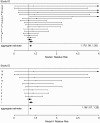A meta-analysis of leukaemia risk from protracted exposure to low-dose gamma radiation
- PMID: 20935290
- PMCID: PMC3095477
- DOI: 10.1136/oem.2009.054684
A meta-analysis of leukaemia risk from protracted exposure to low-dose gamma radiation
Abstract
Context: More than 400,000 workers annually receive a measurable radiation dose and may be at increased risk of radiation-induced leukaemia. It is unclear whether leukaemia risk is elevated with protracted, low-dose exposure.
Objective: We conducted a meta-analysis examining the relationship between protracted low-dose ionising radiation exposure and leukaemia.
Data sources: Reviews by the National Academies and United Nations provided a summary of informative studies published before 2005. PubMed and Embase databases were searched for additional occupational and environmental studies published between 2005 and 2009.
Study selection: We selected 23 studies that: (1) examined the association between protracted exposures to ionising radiation and leukaemia excluding chronic lymphocytic subtype; (2) were a cohort or nested case-control design without major bias; (3) reported quantitative estimates of exposure; and (4) conducted exposure-response analyses using relative or excess RR per unit exposure.
Methods: Studies were further screened to reduce information overlap. Random effects models were developed to summarise between-study variance and obtain an aggregate estimate of the excess RR at 100 mGy. Publication bias was assessed by trim and fill and Rosenthal's file drawer methods.
Results: We found an ERR at 100 mGy of 0.19 (95% CI 0.07 to 0.32) by modelling results from 10 studies and adjusting for publication bias. Between-study variance was not evident (p=0.99).
Conclusions: Protracted exposure to low-dose gamma radiation is significantly associated with leukaemia. Our estimate agreed well with the leukaemia risk observed among exposed adults in the Life Span Study (LSS) of atomic bomb survivors, providing increased confidence in the current understanding of leukaemia risk from ionising radiation. However, unlike the estimates obtained from the LSS, our model provides a precise, quantitative summary of the direct estimates of excess risk from studies of protracted radiation exposures.
Conflict of interest statement
Figures


Comment in
-
Radiation protection in occupational and environmental settings.Occup Environ Med. 2011 Jun;68(6):387-8. doi: 10.1136/oem.2010.058909. Epub 2011 Feb 10. Occup Environ Med. 2011. PMID: 21311089 No abstract available.
-
Risks from nuclear accidents are still uncertain.Occup Environ Med. 2011 Jun;68(6):387. doi: 10.1136/oemed-2011-100157. Occup Environ Med. 2011. PMID: 21565863 No abstract available.
References
-
- United Nations Scientific Committee on the Effects of Atomic Radiation Sources and effects of ionizing radiation, Volume I: sources, Annex E. United Nations, New York, NY: occupational radiation exposures, 2000:654p
-
- International Agency for Research on Cancer IARC Working group on the evaluation of carcinogenic risks to humans: ionizing radiation, Part I, X- and gamma- radiation and neutrons. Lyon, France, 26 May-2 June 1999. IARC Monogr Eval Carcinog Risks Hum 2000;75(Pt 1):1–448 - PubMed
-
- El Ghissassi F, Baan R, Straif K, et al. A review of human carcinogens–part D: radiation. Lancet Oncol 2009;10:751–2 - PubMed
-
- Schubauer-Berigan MK, Wenzl TB. Leukemia mortality among radiation-exposed workers. Occup Med 2001;16:271–87 - PubMed
Publication types
MeSH terms
LinkOut - more resources
Full Text Sources
Medical
